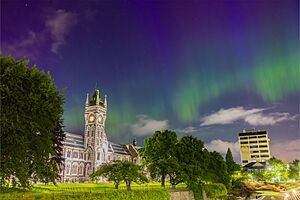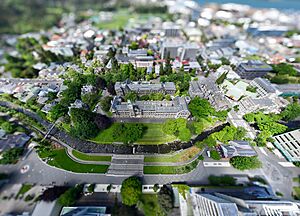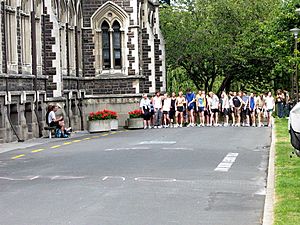University of Otago facts for kids
|
Ōtākou Whakaihu Waka (Māori)
|
|
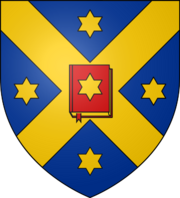
|
|
| Latin: Universitas Otagensis | |
|
Other name
|
Otago University |
|---|---|
| Motto |
Sapere aude
|
|
Motto in English
|
Dare to be wise |
| Type | Public research collegiate university |
| Established | 1869 |
| Endowment | NZD $279.9 million (31 December 2021) |
| Budget | NZD $756.8 million (31 December 2020) |
| Chancellor | Trish Oakley |
| Vice-Chancellor | Grant Robertson |
|
Academic staff
|
1,744 (2019) |
|
Administrative staff
|
2,246 (2019) |
| Students | 21,240 (2019) |
| Undergraduates | 15,635 (2014) |
| Postgraduates | 4,378 (2014) |
| 1,579 (2019) | |
| Location |
,
,
New Zealand
45°51′56″S 170°30′50″E / 45.86556°S 170.51389°E |
| Campus | Urban/University town 45 hectares (110 acres) |
| Student Magazine | Critic |
| Colours | Dunedin Blue and Gold |
| Affiliations | MNU |
 |
|
The University of Otago (Māori: Ōtākou Whakaihu Waka) is a public research university. It is located in Dunedin, Otago, New Zealand. Founded in 1869, Otago is New Zealand's oldest university. It is also one of the oldest universities in Oceania.
A group led by Thomas Burns helped create the university. It was officially started by the Otago Provincial Council in 1869. From 1874 to 1961, the University of Otago was part of the larger University of New Zealand. During this time, it gave out degrees in the name of the University of New Zealand.
Otago is well-known for its lively student life. Students often live in old houses, which they like to name. Students from Otago are sometimes called "Scarfies." This nickname comes from their habit of wearing a scarf during the cold southern winters. The university's graduation song, Gaudeamus igitur, iuvenes dum sumus, means "Let us rejoice, while we are young." The university's student magazine, Critic, is the longest-running student magazine in New Zealand.
Contents
History of the University
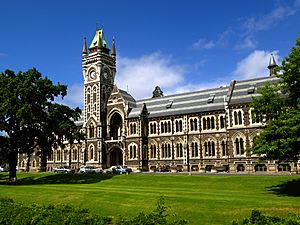

Beginning in the 1800s
The idea for a university in Dunedin came from the Otago Association in the 1840s. This group planned the European settlement of southern New Zealand.
Leaders like Thomas Burns and James Macandrew asked the Otago Provincial Council to set aside land for a university. In 1869, the council officially created the university. They gave it 100,000 acres of land. The university could then grant degrees in Arts, Medicine, Law, and Music. Thomas Burns was named Chancellor, but he passed away before the university opened on 5 July 1871.
The university gave out only one degree before it joined the University of New Zealand in 1874. When the University of New Zealand ended in 1961, Otago got back its power to grant its own degrees.
The university first operated from the Post Office building on Princes Street. It moved to the Clocktower and Geology buildings in 1878 and 1879. These buildings became the Clocktower complex. This is a beautiful group of Gothic revival buildings at the heart of the campus. They were inspired by the main building at the University of Glasgow in Scotland.
Otago was the first university in Australia and New Zealand to allow women to study law. Ethel Benjamin earned her law degree in 1897. She later became the first woman in the British Empire to speak as a lawyer in court.
The 1900s and Beyond
The University of Otago helped train medical staff during the First World War. They provided most of the doctors and dentists for the New Zealand Army.
Professor Robert Jack made the first radio broadcast in New Zealand. This happened from the Department of Physics on 17 November 1921.
Queen Elizabeth II visited the university library with the Duke of Edinburgh on 18 March 1970. This was a special visit. It was the first time the royals did informal "walkabouts" to meet people. It was also the first visit of Prince Charles and Princess Anne to New Zealand.
In May 2010, the university joined the Matariki Network of Universities (MNU). This network includes universities from the US, UK, Canada, Germany, Australia, and Sweden.
In recent years, the university has faced some challenges. In mid-April 2023, it reported a large financial shortfall. This was due to fewer students and less government funding. The university considered reducing staff. Students protested against these proposed changes. In late June 2023, the Government announced more funding for universities. However, Otago still planned some job cuts.
In March 2024, Grant Robertson was named the new Vice-Chancellor. He started in July 2024. This change also brought new leaders to the university.
University Locations and Buildings
University Campuses
The University of Otago's main campus is in Dunedin. This is where the main offices and different study areas are located. These include Health Sciences, Humanities, Business, and Sciences. The beautiful buildings and gardens of the Dunedin campus have been called one of the world's most beautiful university campuses. This was noted by The Daily Telegraph and The Huffington Post.
The university also has four other campuses:
- Christchurch campus: This campus focuses on medical and physiotherapy training. It also does research and offers postgraduate programs.
- Wellington campus: Similar to Christchurch, this campus offers medical and physiotherapy training. It also has research and postgraduate programs.
- Auckland campus: This center offers teaching and distance learning courses. It also connects with the Auckland community and former students.
- Southland Campus (Ahuahu Te Mātauranga): This campus is part of the University of Otago College of Education. It trains teachers for early childhood, primary, and secondary schools.
- The Department of Marine Science also runs the Portobello Marine Laboratory. This lab is located on the Otago peninsula.
University Libraries
The University of Otago has nine libraries. Six are in Dunedin on the main campus. There is also an education library in Southland. Two medical libraries are in Wellington and Christchurch. All libraries offer wireless internet access.
Main Library
The Central Library is a large building with many study spaces. It has computers and places to connect laptops. It holds a special collection of Māori resources called Te Aka a Tāwhaki. It also has Special Collections with about 9,000 old books. In total, the Central Library has over 800,000 print and digital materials. These cover subjects like arts, humanities, business, education, and sciences. It opened in 2001.
Other Libraries
- The Robert Stout Law Library is the university's law library. It is located in the Richardson Building.
- The Health Sciences Library is near the Dunedin Hospital. It has many medical books and journals.
- The Science Library is in the Science III building. It has seating for about 500 students.
- The Hocken Collections is a special research library, archive, and art gallery. It has important items about the history of New Zealand and the Pacific. It was started in 1910 when Thomas Hocken donated his private collection.
- The Robertson Library is the education library. It is run with Otago Polytechnic.
- The Wellington Medical and Health Sciences Library and the Canterbury Medical Library serve students and staff. The Southland Campus also has its own library.
How the University is Organized
University Structure

The university is divided into four main academic areas:
- Division of Humanities
- Division of Health Sciences
- Division of Sciences
- Otago Business School (also called the Division of Commerce)
The Otago Business School is the name used for marketing. It is like business schools in other countries. The university also has special schools. The University of Otago Medical School (started 1875) is one of only two medical schools in New Zealand. Otago is the only university in New Zealand to offer training in Dentistry. Other special areas include Pharmacy, Physical Education, Physiotherapy, Medical Laboratory Science, and Surveying.
There are also many service divisions that help the university run smoothly. These include External Engagement, Financial Services, Human Resources, and Property Services.
Joining with Dunedin College of Education
The University of Otago and the University of Otago College of Education joined together on 1 January 2007. The College of Education trains teachers. Now, the University of Otago College of Education is based at the college site. It includes campuses in Invercargill and Alexandra.
Student Homes (Residential Colleges)
The University of Otago has fourteen residential colleges. These colleges provide food, housing, and support for students. Most of them are for students in their first year. Some also have students in their second year or postgraduate students. While some learning happens at the colleges, most of a student's classes are at the main university.
Colleges try to create a strong community. They have competitions, shared meals, and student clubs. This helps students feel connected and do well in their studies.
The colleges are located around Dunedin:
- Aquinas College
- Arana College
- Caroline Freeman College
- Carrington College
- 192 Castle College
- Cumberland College
- Hayward College
- Knox College
- Salmond College
- Selwyn College
- St Margaret's College
- Studholme College
- Te Rangihīroa College
- Toroa College
- University College
In October 2019, the university announced plans for a new 450-room residential college. It will be called Te Rangi Hiroa. This new college will replace the old one.
University Symbol (Coat of Arms)
In March 2023, the university showed a new proposed logo. This new symbol would replace the traditional coat of arms. It also included a new Māori name for the university. The new symbol is meant to look like the Otakou channel in Otago harbour. The old coat of arms will still be used for special events like graduations. The new Māori name is Ōtākou Whakaihu Waka, which means "A Place of Many Firsts." The university wanted a new look that showed modern Aotearoa New Zealand.
After talking with staff, students, and former students, the university council voted to use the new logo and Māori name on 11 July 2023. The new logo started being used in March 2024.
University Achievements
Special Awards and Research
Many special awards and fellowships are connected to Otago. These include:
- Robert Burns Fellowship (for writers)
- Caroline Plummer Fellowship in Community Dance
- Frances Hodgkins Fellowship (for artists)
- Mozart Fellowship (for musicians)
In 1998, the Department of Physics became famous. They created the first Bose–Einstein condensate in the Southern Hemisphere.
In 2006, a government study looked at research quality. Otago was ranked the top university in New Zealand for its staff and research. It was also ranked first in areas like Clinical Medicine, Law, English Literature, History, and Earth Science. The Department of Philosophy received the highest score for any academic group.
A 2006 report found that Otago was the most research-focused university in New Zealand. About 40% of staff time was spent on research and development.
The journal "Science" has suggested that Otago's Biochemistry database "Transterm" should be studied worldwide. This database has genomic data on 40,000 different species.
University Rankings
| University rankings | |
|---|---|
| QS World | =197 |
| ARWU World | 401-500 |
| US News World | =296 |
| Australian rankings | |
The University of Otago is highly ranked among universities around the world.
- In the 2026 Quacquarelli Symonds World University Rankings, it was ranked #197 globally. This makes it the 2nd best in New Zealand.
- In the Times Higher Education World University Rankings 2025, it was ranked between #351-400 globally. This also makes it 2nd in New Zealand.
- In the 2024 Academic Ranking of World Universities, it was ranked between #401-500 globally. This places it tied for 2nd-4th in New Zealand.
Student Life at Otago
Orientation Week (O-Week)
'O-Week' is short for Orientation Week. It is like a welcome week for new students at Otago. New students are often called 'freshers' or 'first-years'. The Otago University Students' Association organizes O-Week. It includes fun activities and competitions. There are concerts, comedy shows, and other events. Often, a Highlanders rugby game is played during this week. Local businesses also have special events and live music.
- Traditions
Each year, new students are encouraged to join the toga parade. They dress in white sheets like togas. This tradition was brought back by the OUSA with a festival at the stadium. A "clocktower race" also happens. Students race around the clocktower building. They start when the clock chimes at noon and must finish before the chimes stop. It is a challenging race, but some students complete it each year.
Student Conduct
Student behavior is important to the university and the people of Dunedin. In 2007, the university started a Code of Conduct (CoC) for its students. They also created 'Campus Watch', a security team. Campus Watch helps keep an eye on safety and behavior on campus and in student areas.
- Protests
Otago students have a history of protesting about important issues. In the 1960s, students protested against the Vietnam War. They also challenged rules about males and females sharing housing. In September 1993, students protested against a fee increase. In 1996, students occupied the Clocktower Building to protest another fee increase. This led to limits on how much fees could go up.
Notable People from Otago
University Leaders (Chancellors)
The Chancellor is a very important leader at the university. Here is a list of people who have been Chancellor:
| Name | Portrait | Term | |
|---|---|---|---|
| 1 | Thomas Burns |  |
1869–1871 |
| 2 | John Richardson |  |
1871–1876 |
| 3 | Henry Samuel Chapman |  |
1876–1879 |
| 4 | Donald Stuart |  |
1879–1894 |
| 5 | Joshua Williams |  |
1894–1909 |
| 6 | James Allen |  |
1909–1912 |
| 7 | Andrew Cameron |  |
1912–1925 |
| 8 | Thomas Sidey |  |
1925–1933 |
| 9 | William John Morrell |  |
1933–1945 |
| 10 | David Herron |  |
1946–1955 |
| 11 | Hubert Ryburn |  |
1955–1970 |
| 12 | Stuart Sidey |  |
1970–1976 |
| 13 | Jack Somerville |  |
1976–1982 |
| 14 | Jim Valentine | 1982–1992 | |
| 15 | Judith Medlicott | 1993–1998 | |
| 16 | Eion Edgar |  |
1999–2003 |
| 17 | Lindsay Brown |  |
2004–2008 |
| 18 | John Ward |  |
2009–2017 |
| 19 | Royden Somerville |  |
2018–2022 |
| 20 | Stephen Higgs |  |
2022–2024 |
| 21 | Trish Oakley | 2024–present |
Vice-Chancellors
The Vice-Chancellor is the chief executive of the university. Here is a list of people who have held this role:
| Name | Portrait | Term | |
|---|---|---|---|
| 1 | Robert Aitken | 1948–1953 | |
| 2 | Frederick Soper | 1953–1963 | |
| 3 | Arthur Beacham | 1964–1966 | |
| 4 | Robin Williams | 1967–1973 | |
| 5 | Robin Irvine | 1973–1993 | |
| 6 | Graeme Fogelberg | 1994–2004 | |
| 7 | David Skegg |  |
2004–2011 |
| 8 | Harlene Hayne |  |
2011–2021 |
| 9 | David Murdoch | 2022–2023 | |
| − | Helen Nicholson (acting) | 2023–2024 | |
| 10 | Grant Robertson |  |
2024–present |
University Staff (Faculty)
Many talented people have worked at the University of Otago. Some of them include:
- Muriel Bell, a nutritionist and medical researcher
- Agnes Blackie, the first female physics academic
- Carolyn Burns, a zoologist who won the Marsden Medal
- Alice Copping, a nutritionist
- John Carew Eccles, a medical researcher
- Jim Flynn, a researcher of intelligence and philosopher
- Christina Hulbe, an Antarctic researcher and glaciologist
- Robert Jack, a physicist
- Lisa Matisoo-Smith, a professor of biological anthropology
- Pauline Norris, a pharmacy professor
- David Skegg, an epidemiologist
Former Students (Alumni)
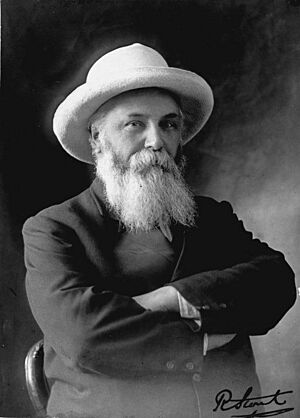
Many successful people have studied at the University of Otago. Here are some of them:
- Rui Maria de Araújo, a former Prime Minister of Timor-Leste
- Rayyanah Barnawi, a Saudi astronaut
- Dame Silvia Cartwright, a former Governor General
- Nathan Cohen, a world and Olympic champion rower
- Bill English (Selwyn College), a former Prime Minister of New Zealand
- Janet Frame, a famous writer
- Caroline Freeman, the first female graduate of the University of Otago
- Sir Harold Delf Gillies, a plastic surgeon
- Sir Peter Buck, a doctor, military leader, and anthropologist
- David Kirk (Selwyn College), a former All Black captain and businessman
- Josh Kronfeld (Aquinas College), an All Black rugby player
- Tania Lineham, a science teacher who won a Prime Minister's Science Teacher Prize
- John Edward "Jack" Lovelock, a famous athlete
- Kamisese Mara (Knox College), a politician
- Stella Maxwell, a fashion model
- Archibald McIndoe, a plastic surgeon
- Anton Oliver (University College), a former captain of the All Blacks
- Lord Porritt (Selwyn College), an Olympian, physician, and former Governor-General
- Robert Stout (Aquinas College), a former Prime Minister of New Zealand
Rhodes Scholars
A Rhodes Scholarship is a very special award that allows students to study at Oxford University in England. Here are some Rhodes Scholars from Otago:
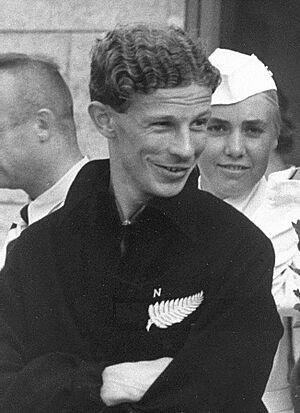
- 1907 Colin Macdonald Gilray
- 1923 Rt Hon. Lord Arthur Espie Porritt
- 1931 Dr John Edward (Jack) Lovelock
- 1932 Sir Geoffrey Sandford Cox
- 1934 Norman Davis
- 1936 Daniel Marcus Davin
- 1952 Hon. Hugh Templeton
- 1960 Dr James Julian Bennett Jack
- 1968 Christopher Robert Laidlaw
- 1985 Dr David Kirk
- 1988 Dr Ceri Lee Evans
- 2007 Holly Walker
See also
 In Spanish: Universidad de Otago para niños
In Spanish: Universidad de Otago para niños
- University of Otago School of Performing Arts and Allen Hall Theatre
- List of Honorary Doctors of the University of Otago
- Scarfies


